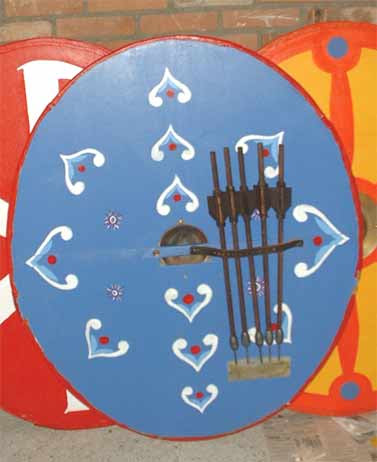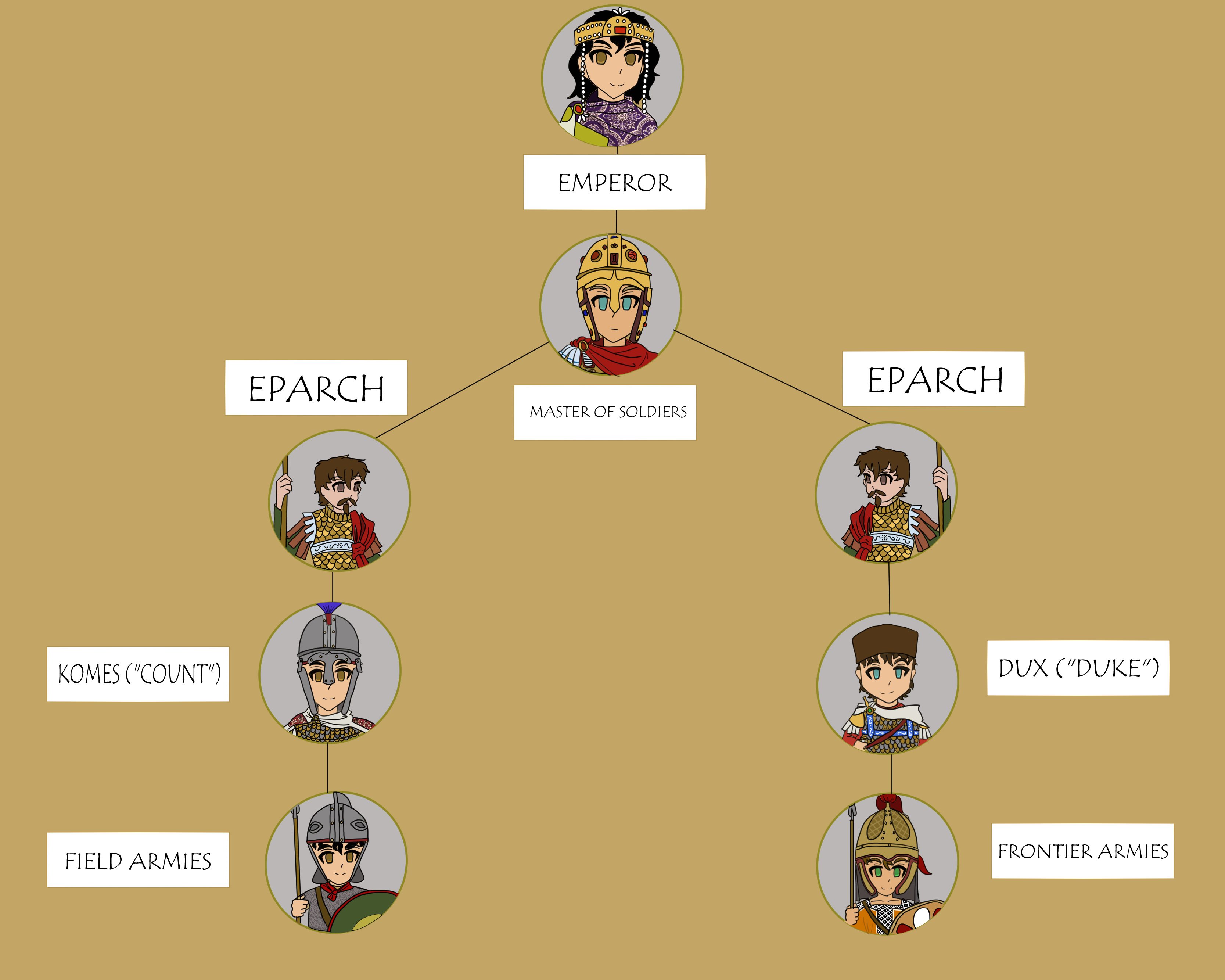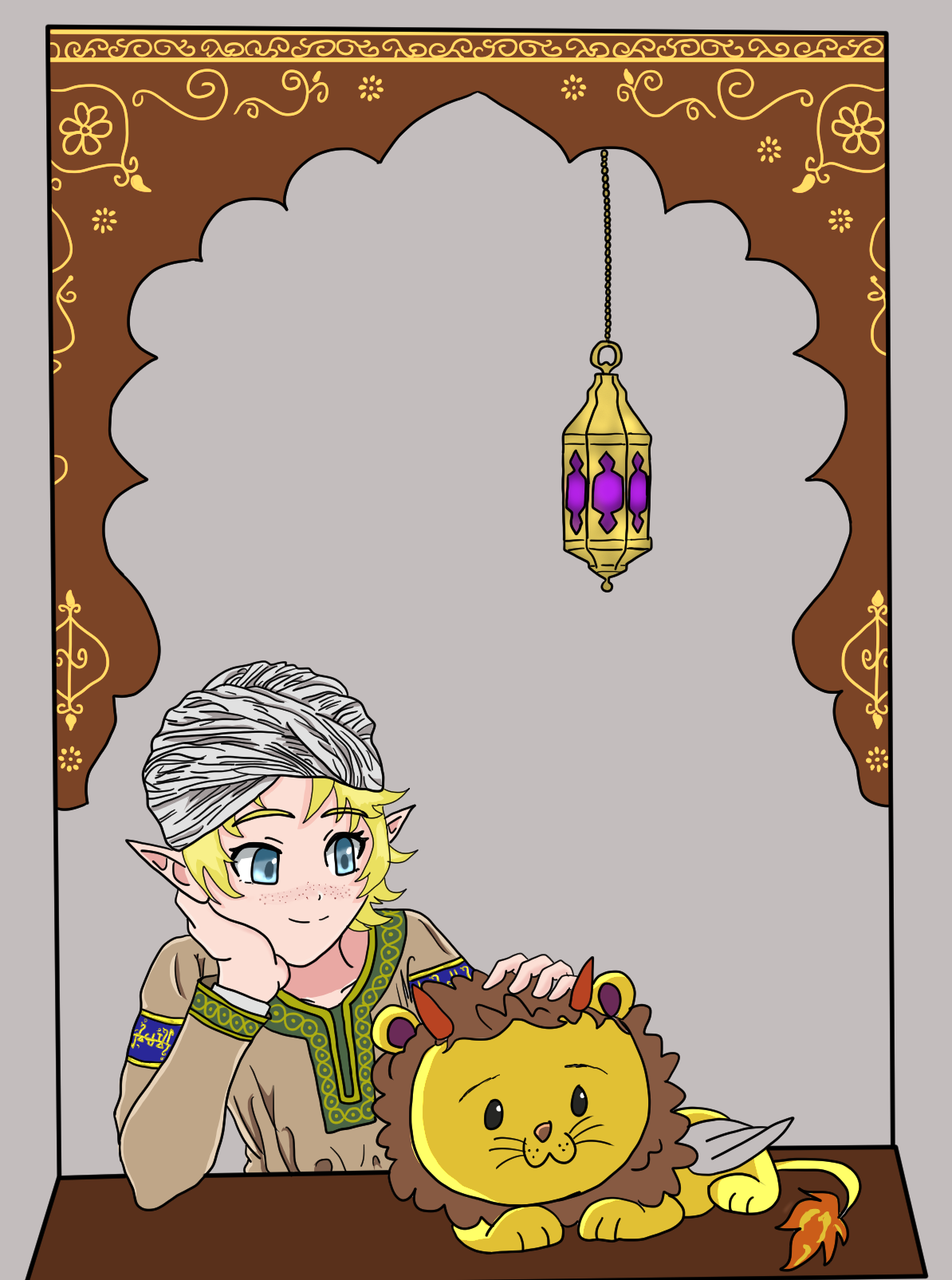Legionary
The Ikarian/Blatian legionaries are perhaps the most feared and disciplined forces in all of Yeia, conquerors and later protectors of a mighty Empire and civilization. Ikaria's downfall four centuries ago might have given the impression that such soldiers were soon going to dissapear from the battlefields, but far from that, the sons of Zerah have known how to adapt to circumstances and external influences in order not only to survive themselves and their military traditions, but this has also served them to initially defend what remains of the glory of Ikaria and in the last century apparently restore it.
 In addition to this, other specialized troops like artillerymen, archers or cavalrymen had their own exercises. Archers and artillery men would practice their shots in the archery range and the cavalry would practice riding and manouvers outside the fortresses. Every legionary was (at still is) expected to know to use a sling properly. Slings were sometimes used to shoot at approaching enemies, especially if they had little or no armor or protection.
This training is basically still the same used nowadays, and it has shown its effects in the battlefields across Yeia.
In addition to this, other specialized troops like artillerymen, archers or cavalrymen had their own exercises. Archers and artillery men would practice their shots in the archery range and the cavalry would practice riding and manouvers outside the fortresses. Every legionary was (at still is) expected to know to use a sling properly. Slings were sometimes used to shoot at approaching enemies, especially if they had little or no armor or protection.
This training is basically still the same used nowadays, and it has shown its effects in the battlefields across Yeia.
Origins
The legions of old Ikaria are as old as the Empire itself. For the first five centuries of the Empire the Legions were just Ikarian citizens called by their Emperor and the Senate for a campaign and their appearance and fighting style wasn't very different from that of their ancestors before they migrated. Some even suggest that both the Oronai and the Ikarians fought as hoplites during this early centuries after their migration . This early legions were vital for the early expansion of the Empire into the peninsula of Moria where they had to fight a brutal war against the mountain tribes that a millenia earlier had forced the ancestors of the Seris to cross to the continent of Karia in search of a new home. It appears that it was during this early conflicts that the hoplite fighting style was abandoned by the Ikarians in favour of a more flexible formation and also prefering close quarters combat with swords rather than fighting with spears, thus, the traditional fighting style of the Ikarian legionary was born. In the following centuries the Ikarian legions at their legionaries would fight across South-Eastern Karia, mainly on the multiple campaings against their cousins, the Kallian peoples and lastly in the Elven territories conquering the entire coast of the Interior Sea. In this process they earned their reputation as Teria's and perhaps Yeia's most powerful and feared fighters. During the 1st century BP the Legionary would be another pawn in the power game of ambitious princes and generals who will try to assume the imperial title, as this was the time of great political instability and civil wars, but still, the Ikarian legions were still a force to be reckoned with. The Ikarian-Seris war of the early 200s was a blow to the mighty legions, which were utterly defeated by the Seris armies and the Namru warriors. It was the first time in more than half a millenia that the Ikarian legions were defeated. This was a tremendous shock and a result of this the Legions and the Ikarian army in general underwent a series of reforms that affected both the legionaries' equipment as well as the organization of the imperial armies. After this the next two centuries saw the legions trying to defend the Empire from the raids and invasions from the other side of the Albine mountains. The fall of Ikaria in 460 AP didn't mean the dissapearance of the legionary, quite the contrary, the legionaries of the sucessor states of the Ikarian Empire have fought bravely since then to repell the invaders and they set themselves up as "defenders of civilization" tough in terms of equipments, as it will be shown, they resemble little the legionaries of the first millenium BC who conquered an empire.Training
Training has always been essential for the survival, discipline and combat performance of legionaries and it is one of the key reasons for their success on the battlefield. In earlier times legionaries, as militia or levy soldiers, were expected to train their fencing techniques at their homes at least once a week, and to train with their local unit at least the same ammount of time. As the army became a professional force after the 4th century BP and the legions began to be stationed at permanent fortresses, the legionaries began to have more time for training, almost every day. The soldiers at the fortresses not only did they practice formations and combat maneuvers alongside the rest of their centuries and cohorts, but they also practiced hand-to-hand combat, usually with double-weighted weapons and against a wooden post, under the supervision of their officers. Another exercise consisted of fighting an opponent in full gear and with false souls whose ends were padded. These ends were sometimes dipped in paint so that the blows inflicted by each soldier could be observed and thus their accuracy could be checked.
Legionaries training by Pavel Šimák (AMELIANVS)
Equipment and weapons
The equipment of the Ikarian/Blatian legionaries changed over the centuries, adapting to changes in battlefields and foreign influences. In general terms, the legionary's equipment consists in a metal helmet, a large oval a sword and a pair of javelings (and after the reforms after the Ikarian-Seris War in the 3rd century) an spear.Evolution
In the first five centuries, the legionary wore a bronze helmet with plumes on top (to make it look taller and more intimidating) an oval shield made of glued planks of wood covered first with canvas and then with calfskin. Then, over his tunic, he would wear some kind of bronze armour, either an anatomica cuirass, a linothorax (an Oronai invention) or, most commonly. an armour made of bronze plates. The two pair of javelins seem to have been an adaptation against the mountain tribes of the Moria Peninsula, and last but not least, his main weapon, a short stabbing sword, some of these types of swords were similar to the ones still used by Oronai soldiers. From the end of th 3rd century BP to the 3rd century AP the appareance of the Ikarian legionary varied little, the only important changes were the introduction of chainmail, which became the main type of armour and the shield became bigger and slightly curved, almost similar to a tile but with an oval shape. This gave the soldier better protection in combat. The real change came after the dissastrous Ikarian-Seris War, after this, seeing the success of the Seris infantry the Ikarians began to copy their armour and weapons and, in true Ikarian fashion, improving them. The shields became circular and scale armour was introduced as well as Seris style helmets, cheaper to manufacture. Spears replaced the sword as the primary weapon, and the pair of javelins were replaced by little darts that the soldiers carry in a quiver inside their shields. Talking about swords, they have became longer, similar to the swords already used by the Ikarian cavalry, designed more for slashing rather than stabbing, but still effective for doing the latter. Overall, This is how the average Ikarian and later Blatian legionary has been equiped to the present time. Although some legionaries from the legions that are under the direct command of the Emperor of Blati still retained some archaic appearance, mostly for prestige. This units still fight as primarily soldiers throwing their two pair of javelings before charging the enemy. These archaic appearance was also mantained in the legions under the Republic of Valia but since the 7th century AP the legionaries of the young Republic began to be armed with armours and weapons from the continent of Karia, making them so indistiguishable from their fellow legionaries in the continent of Teria, that you only know they're legionaries because of the language they speak and the way they fight.Fighting style
For most of its history the legionary has been primarily a swordsman, and a swordsman so skilled and lethal that for centuries they were considered the best swordsmen in the world (some say that together with the Namru of the Seris, except that for centuries they used the sword as a secondary weapon). The way legionaries fight is based on fighting in formation, on teamwork of legionaries as a unit, outside of it these soldiers are easy targets. Before the war with the Seris, before charging or before receiving the enemy's charge and consequently disrupting it or reducing its speed by confusing the enemy, the legionary would throw his pair of javelins to inflict as many casualties as possible on the enemy and, seconds later, unsheath his swords and charge against the enemy. During training they were taught (and legionaries are still taught) to attack, mainly by stabbing, the most vulnerable parts of the enemy, such as the belly, the limbs, the neck and especially armpits and the groin (which are usully unprotected). After the reforms , the legionaries began to use the spear as their first weapon, they still fight in tight formations of heavy infantrymen, throwing the darts to the enemy before colliding with them. In case the combat becomes really close, the legionary can use his swords with the same proficency as in old times. Legionary archer and artillery numbers increased after the reforms, and so the legions have even more firepower to throw at the incomming enemy before charging.Payment
In the first three centuries of the Ikarian Empire the legionaries were paid by the state (or by their generals) with bags of salt, or that's what the legend says, hence the word "salary". But the first documents of payment we have, dated from the 6th century AP mentioned that the legionaries were paid in coin. Since the first century BP onwards, most of the units were stationed in the frontiers, near the Albine Mountains and in the south, close to the Kingdom of the Green Elves. These units received a fixed , yearly payment, called the Donativon (around 20.000 golden coin to be distributed among the legions stationed in a province). Aside of this payment there were also Imperial "gifts" that the emperor can bestow to his loyal soldiers, perhaps commemorating his accession to the throne, or rewarding his legionaries for their loyalty or for putting him on the throne (or for defending the emperor from a usurper). These two ways of payment are still used by the successor states of Ikaria, mainly Blatian Empire, Cloudia. In the Republic of Valia, as there is no emperor, there is only the Donativon.Organization
Each legion is composed of around 5000 men, although these numbers are hypothetical since the legions are not always at full strength due to soldier's diseases, leaves of absence, or detachments of legions (called vexillationes) sent to other areas for various reasons. This 5000 men are split into 10 cohorts, nine of 480 men each ( 6 centuries of around 80 men) , with the first cohort being almost double-strength at 800 men. In the past 300 soldiers of the 5000 total were cavalrymen, but the ratio increased following the reforms of the 3rd century. Now of the 5000 soldiers, around 1000 are cavalry, 1500 are archers, skirmishers and artillerymen and the remaining 2500 are infantry soldiers. In terms of army officers, the legion is commanded by a Legate (appointed by the Emperor or the Senate, second in command is the Bikarios and then around 10 tribunes (usually sons of the Blatian aristocracy in his early teens that need military experience in order to enter politics when they reach adulthood). Following the tribunes is the Campidoctor ( a high ranking centurion in charge of the legion's training), after him come the centurions, the commanders of a century of around 80 men, their deputies the "optiones" and lastly the common legionaries. Other essential officers for a legion are the Adiutor (the legion's clerk, in charge of the unit's written records and agenda the Actuarios ( the supply officer), the Cornicen (in charge of sound orders to the legions) and the Signifier (the standard-bearers, who if wearing a dragon, were called Yviannarios in Ikarian)Two types of soldiers after the reforms
After the reforms the legionaries were divided into two types, frontier soldiers and field army soldiers. The frontier armies, as the name implies, are stationed near the frontiers. In the first two centuries of the Empire the frontiers of the empire were those territories on the border with the barbarian realms (either nords or crorai) that existed in former imperial lands. After the mid 600s AP when most of this kingdoms were conquered by the Blatians, the armies were stationed again near the Albine mountains, as they had been in the past. This frontier armies are commanded by a Dux or "Duke". The soldiers of this type of army are known as "Kastresianoi" litterally meaning "The encamped ones" because of their permanent stationing at fortresses and camps alongside the frontier. On the other hand, the field armies have the task of intercepting the invading armies if they cross the frontier, or, in case the Blatians are on the offensive, destroy the enemy army and besiege their cities. They are stationed in fortresses, castles and cities across the country. Each field army unit is commanded by a Comes or "Count" . There is an special type of field armies that are called the Armies "in the Presence of the Emperor" commanded by the Emperor himself or by his deputy, the Master of Soldiers. This army is stationed at the capital, Blati and, since the early 8th century, there is also one army of this type stationed at the old imperial capital of Ikaria. Both armies gather together when a big campaign against a barbarian kingdom or other enemy is going to take place. Because they're the personal army of the Emperor they are the elite of the Blatian forces.
Overall training Level
Professional
Assumed Veterancy
Experienced
Ranks & Titles
Military oath
Said when the new recruit joins the army and renewed each New Year's Day in the presence of their offices:I solemnly swear, by the Prophet, by all the Gods, and by the Emperor, that I shall faithfully execute all that he commands, that I shall never desert the service, and that I shall not seek to avoid death for the Empire of the Ikarians!












Wonderful art as always, Deivi! I love seeing the evolution of their arms and armour :D
Maker of Maps
Awww thank you so much Dhelian!!! :3